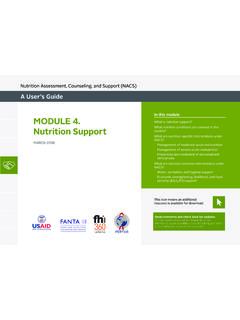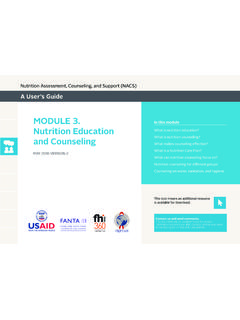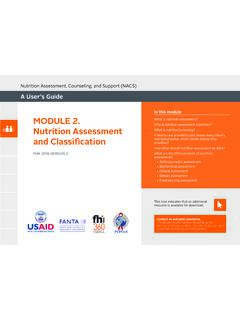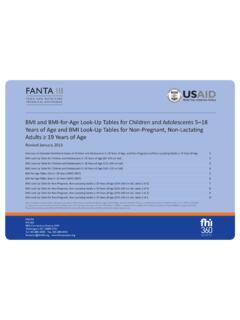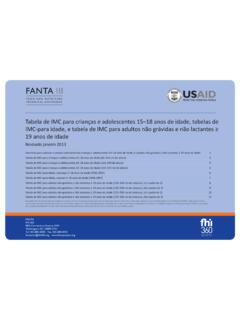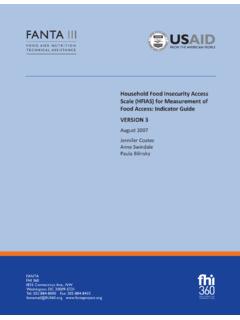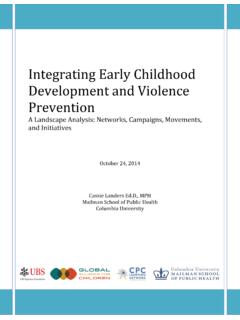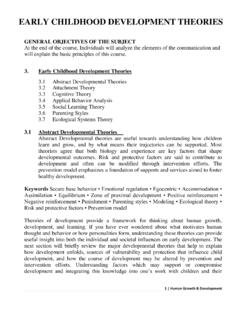Transcription of Giving Children the Best Start in Life: Integrating ...
1 TECHNICAL BRIEFFood and Nutrition Technical Assistance III Project January 2016 Giving Children the Best Start in Life: Integrating Nutrition and early childhood development Programming within the First 1,000 Days Zeina Maalouf-Manasseh, Lesley Oot, and Kavita Sethuraman Source: Valerie Caldas, courtesy of PhotoshareKey Points1. Investment in integrated nutrition and early childhood development programming during the first 1,000 days is critical to ensure that Children can reach their potential. 2. There are five key nutrition risk factors for poor ECD: poor maternal nutrition, iodine deficiency during pregnancy, iron deficiency, poor linear growth, and severe acute Integrated nutrition and ECD interventions have the potential for greater cumulative impact on nutrition and ECD outcomes compared to single-sector every child with the best Start in life is not only essential for the child s individual well-being but is a necessary investment to protect human capital and achieve national development objectives.
2 Chronic malnutrition (or stunting, low height-for-age) affects an estimated 165 million Children worldwide, a majority of whom live in developing Most of these Children are also not achieving their development potential due in large part to chronic malnutrition. In fact, it is estimated that more than 200 million Children under 5 years of age in developing countries are not achieving their development potential due to both chronic malnutrition and Adequate nutrition is critical for brain development and plays an important role in a child s physical, social, emotional, and cognitive development the four domains of early childhood development (ECD) in which Children need to develop to reach their potential.
3 Aside from adequate nutrition, Children also need a stimulating environment and social interaction with attentive caregivers to develop sufficiently in all four domains. Adequate nutrition is critical to a child s optimal development , particularly during the first 1,000 days (pregnancy through the child s second birthday), a period of rapid growth where nutrient deficiencies can have long-term consequences. Studies have found that malnourished Children are more likely to be older at school enrollment, repeat grades, be absent from school, drop out of school, and fail at least one grade, resulting in decreased learning and lower wages in Recent evidence also suggests that integrated nutrition and ECD programming is synergistic and FANTAIIIFOOD AND NUTRITIONTECHNICAL A SSISTANCETECHNICAL BRIEF Integrating Nutrition and early childhood development Programming within the First 1.
4 000 Days2that the benefits can extend to both improved child development and nutrition outcomes, laying the best foundation for Children to do well in school and achieve their full potential as adults. However, despite the interaction between optimal nutrition and child development during the first 1,000 days, most programs do not yet effectively integrate ECD interventions within nutrition and health services targeting Children under 2, resulting in a missed opportunity. One of the guiding principles of the Agency for International development s 2014 2025 Multi-Sectoral Nutrition Strategy is the promotion and strengthening of coordinated multisectoral approaches, which include early child care and development , to address the multiple causes of malnutrition.
5 This provides an opportunity to explore other critical interventions that can be integrated with nutrition programming to provide the best impact on child development . This technical brief focuses on the interaction between nutrition and ECD during the 1,000-day window of opportunity. It outlines the key nutritional risk factors related to poor ECD and proven nutrition interventions to address them, with a particular focus on two distinct time periods: pregnancy and early childhood (defined in this brief as 0 23 months of age). It also outlines how current programs are implementing integrated programming to address both nutrition and ECD, the advantages and disadvantages of this integration, and the potential impact such integrated programs can have on improving a child s growth and development .
6 The aim is to support evidence-based integrated program design that would seek to improve both nutrition and ECD outcomes in the s Impact on early childhood development during the First 1,000 DaysNutrition impacts ECD both directly and indirectly. Nutrition has a direct impact on brain development during the first 1,000 days, a period of rapid brain growth and development where sufficient quantities of key nutrients are needed in differing amounts at critical periods to ensure the brain is developing properly. This is because regions of the brain ( , the hippocampus) and brain processes ( , synapse formation) require different nutrients at different times and amounts to develop.
7 For example, the brain s demand for zinc, which is necessary for cell division among other neurodevelopmental processes, is particularly high during the last four months of gestation and from 6 months to 10 years of ,4 Children s nutritional status can also influence their behavior, indirectly impacting their development through two key pathways childhood exploration and caregiver interaction. Without proper nutrition, Children may not have the energy or interest to explore their environment, limiting their interaction with new situations, senses, and In addition, Children who are adequately nourished may be more active and demand greater attention and responsiveness from their caregiver, while malnourished Children may be frequently ill and therefore more irritable, eliciting negative and less stimulating responses from a Malnourished Children may also be harder to feed.
8 Leading caregivers to provide less food and use a non-responsive and less stimulating manner of Finally, since malnourished Children may appear younger than they actually are (either due to reduced weight or height), they may receive stimulation that is not appropriate for their actual age, further stunting their Figure 1 shows the different pathways by which malnutrition may directly and indirectly affect ECD. Key Nutrition Risk Factors Associated with early childhood development during the First 1,000 DaysAdequate intake of energy, protein, fatty acids, and micronutrients (including iron, folic acid, thiamine and other B vitamins, iodine, vitamin A, zinc, vitamin D, and calcium) during the first 1,000 days is critical to a child s optimal development and growth.
9 For example, sufficient folic acid intake before and during pregnancy is critical to the forming of the neural tube and the brain stem. Deficiency during pregnancy can cause the neural tube to form improperly and cause birth Although each of these micronutrients and macronutrients is essential for brain development and its functioning i Global evidence indicates that while zinc has a direct effect on brain growth and morphology, current evidence does not suggest that zinc supplementation influences early childhood development BRIEF Integrating Nutrition and early childhood development Programming within the First 1,000 Days3throughout life.
10 This technical brief focuses on the following key nutrition-related risk factors that evidence shows have a measured association with ECD: poor maternal nutrition, iodine deficiency during pregnancy, iron deficiency, poor linear growth (stunting), and episodes of severe acute malnutrition (SAM).ii The risk factors have been divided into two time periods: pregnancy and early childhood . Figure 1. Potential Mechanisms by Which Malnutrition May Influence a Child s early DevelopmentNutritional statusPhysical growthIllnessPhysical activityCaregiver behavior, parent-child interactionBrain development and functionLevel of child interaction with the environmentCognitive, motor, and socio-emotional developmentSource: Prado and Dewey 2012, adapted from Levitsky, and Barnes, 1972.
